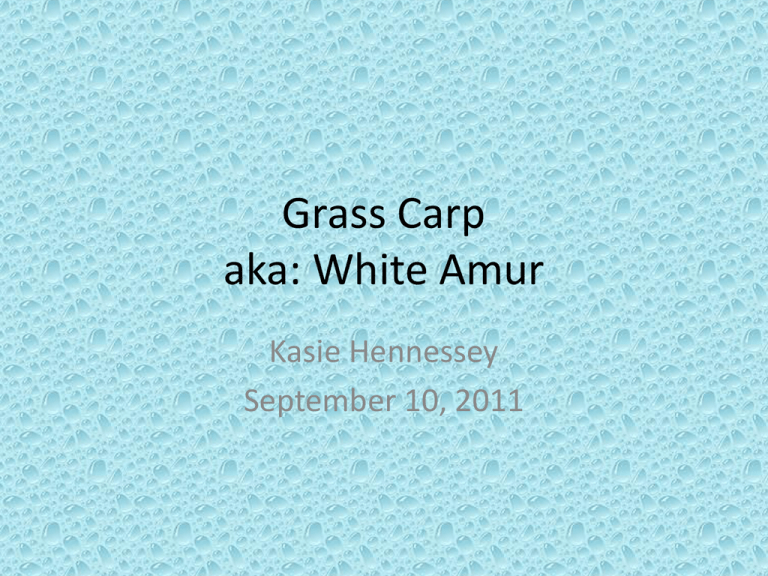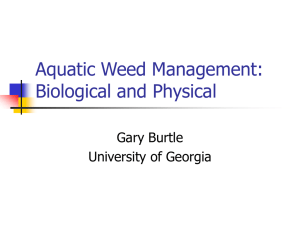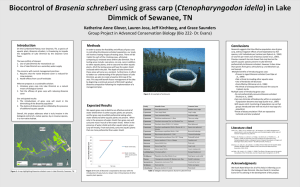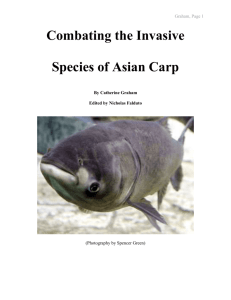Grass Carp
advertisement

Grass Carp aka: White Amur Kasie Hennessey September 10, 2011 Grass Carp • Grass Carp are also known as White Amur (however, they are only called this in the United States to avoid the derogatory term “carp”) • They are a herbivorous, freshwater fish • They are native to Malaysia, the river system of northern China and southern Siberia • They were imported by the U. S. Fish and Wildlife Service in 1963 for research in aquatic plant control. Grass Carp Grass Carp Size • Grass Carp can reach a size of at least 35 to 40 lb. in ponds in mid-western states. • Their life expectancy is 8 to 12 years. Some do live longer, but the larger they get the less they eat so they are less effective in plant control. • Older fish give the impression of being related to submarines. They can reach 4 feet and 100+ pounds in their native rivers. • Amur are usually stocked at 10 to 12 inches. An 8 inch minimum is a required to keep them from becoming expensive bass food! Interesting Facts About Grass Carp • Will grow rapidly and reach at least ten pounds. They have been known to reach 40 pounds in the southern United States. • Will not eat fish eggs, young fish or invertebrates, although baby grass carp are omnivorous. • Feed from the top of the plant down so that mud is not stirred up. • In ponds and lakes where grass carp have eliminated all submersed vegetation the water becomes smoky. Hungry fish will eat the organic material out of the sediments. Interesting Facts About Grass Carp • Are dormant during the winter. Intensive feeding starts when water temperatures reach 52 degrees. • Are a river fish and prefer flowing waters to still waters. • Are difficult to recapture. So, make sure you REALLY want them in your pond or lake. • They may not feed in swimming areas, docks, boating areas, or other sites where there is heavy human activity. Cool Facts about Grass Carp • Grass carp possess specially developed pharyngeal (tube that connects the mouth and nasal passages with the esophagus) bones that perform like teeth and let them tear free and grind aquatic plants. • Latitude, water temperature, food availability, and age determine how large the grass carp will grow. WHY have Grass Carp??? • Grass Carp or White Amur can effectively control aquatic vegetation in ponds and lakes. • Yearly chemical weed control can costs thousands of dollars. • Grass carp are very cheap, costing on average about $10$20 per fish. • 10 grass carp per acre would only cost you about $140.00 per acre and the grass carp will control weed growth for 6 to 8 years. • Grass carp are very effective in controlling submersed grasses and can eat up to 5 times their body weight in one day. • They will live longer than 8 yrs, but the larger fish do not control vegetation like the younger actively growing ones. Videos on Grass Carp • http://www.youtube.com/watch?v=45Cw14sl e4k&feature=player_detailpage • http://www.youtube.com/watch?feature=play er_detailpage&v=3aNV3lPesUY Triploid Grass Carp • Grass carp possess specially developed pharyngeal (tube that connects the mouth and nasal passages with the esophagus) bones that perform like teeth and let them tear free and grind aquatic plants. • In 1981, researchers developed a method to create sterile, non-reproducing grass carp by exposing the fertilized eggs to heat shock. These sterile grass carp are called triploid. • Determination of the fertility or sterility of grass carp occurs by analyzing a drop of blood taken from the fish. • This process results in fish of both sexes having three sets of chromosomes (triploid) instead of the normal two sets of chromosomes (diploid). GRASS CARP CAUTIONS • Predatory fish, such as largemouth bass, eat grass carp. • If used with existing fish populations, grass carp should be large enough to avoid being eaten by the average size predator. • Even if predation is not a problem, the pond owner should consider using larger carp if they are available because they tend to survive handling and stocking better. • Grass carp stocked with existing fish populations should be at least 8-10 inches in length. CAUTIONS • Grass carp do not reproduce in ponds and periodic restocking is required. • Once stocked, grass carp are difficult to remove from a pond. They are almost impossible to remove by seining (fishing with nets) or angling(fishing with hook and line). The only options are draining the pond or using toxins. Disadvantages of Grass Carp • Depending on plant densities and types, it may take several years to achieve plant control using grass carp. • The type of plants grass carp prefer may also be those most important for habitat and for waterfowl food. • If the area is overstocked, all submersed aquatic plants may be eliminated. • Removing excess fish is difficult and expensive. Disadvantages of Grass Carp • If not enough fish are stocked, less-favored plants, such as Eurasian milfoil, may take over the lake. • Stocking grass carp may lead to algae blooms. • All inlets and outlets to the lake or pond must be screened to prevent grass carp from escaping into streams, rivers, or other lakes. • In some areas the grass carp are required to be sterile (tripolds) • In many cases there is an ALL or NOTHING approach to weed control. Resources • Longevity and Persistence of Triploid Grass Carp Stocked into the Santee Cooper Reservoirs of South Carolina. Journal article J. Aquat. Plant Manage. 41: 90-92 by: James P. Kirk and Robin C. Socha • Http://lakework.com/site/grass-carp.php • http://www.ecy.wa.gov/programs/wq/plants/ma nagement/aqua024.html • www.youtube.com • http://warnell.forestry.uga.edu/service/library/in dex.php3?docID=185&docHistory%5B%5D=1 • http://www.fish.state.pa.us/images/pages/forms /pfbc_tgc002.pdf











